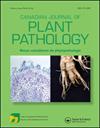Interactions among cereal cyst nematode Heterodera filipjevi, dryland crown rot Fusarium culmorum, and drought on grain yield components and disease severity in bread wheat
IF 1.5
4区 农林科学
Q3 PLANT SCIENCES
引用次数: 5
Abstract
Abstract The cereal cyst nematode (CCN) Heterodera and crown rot caused by Fusarium species limit cereal production and yield potential. Losses increase when CCN and crown rot occur together, especially under water stress conditions. The objective of this study was to investigate the interactions among Heterodera filipjevi, Fusarium culmorum, and drought on a set of wheat germplasm with differing levels of resistance/tolerance to CCN, crown rot and drought. Plant emergence was significantly reduced (56% seedling death) when seeds were planted in a water stress environment where F. culmorum and H. filipjevi were present. Crown rot was more severe under water stress compared with Fusarium inoculation alone. The number of cysts fell significantly when H. filipjevi was co-inoculated with F. culmorum, revealing an antagonistic interaction between the nematode and fungus. The highest number of cysts was found on the susceptible accession ‘Seri’ under water stress conditions. Water stress caused a significant reduction in plant height, while F. culmorum inoculation did not, unless combined with water stress. Yield components were significantly reduced by each of the single stresses and losses were greater when plants were exposed to double or triple stresses. Water stress and F. culmorum inoculation caused a significant reduction in spike weight and seeds per spike. The chlorophyll content of wheat leaves was negatively affected by water stress and inoculation by both nematode and fungus. In conclusion, water stress exacerbates the damage caused by CCN and crown rot, and planting drought-resistant varieties would be an ideal solution to reduce losses.禾谷孢囊线虫Heterodera filipjevi、旱地冠腐镰刀菌和干旱对面包小麦产量构成和病害严重程度的相互作用
摘要谷物包囊线虫(CCN)异线虫和镰刀菌引起的冠腐病限制了谷物的生产和产量潜力。当CCN和冠腐同时发生时,损失增加,特别是在水分胁迫条件下。摘要本研究以具有不同CCN、冠腐病和干旱抗性/耐受性的小麦种质为材料,研究了菲氏异源菌(Heterodera filipjevi)、镰刀菌(Fusarium culmorum)和干旱之间的相互作用。当种子种植在有F. culmorum和H. filipjevi存在的水分胁迫环境中时,植物出苗率显著降低(56%幼苗死亡)。与单独接种镰刀菌相比,水分胁迫下的冠腐病更为严重。与F. culmorum共接种时,孢子囊数量明显减少,表明线虫与真菌之间存在拮抗作用。在水分胁迫条件下,敏感品种‘Seri’的包囊数量最多。水分胁迫导致植株高度显著降低,而接种枯霉则没有显著降低,除非与水分胁迫相结合。单次胁迫显著降低了植株的产量,双、三重胁迫损失更大。水分胁迫和接种黑穗病菌可显著降低穗重和穗粒数。水分胁迫和线虫、真菌接种对小麦叶片叶绿素含量均有负向影响。综上所述,水分胁迫加剧了CCN和冠腐病的危害,种植抗旱品种将是减少损失的理想解决方案。
本文章由计算机程序翻译,如有差异,请以英文原文为准。
求助全文
约1分钟内获得全文
求助全文
来源期刊
CiteScore
4.50
自引率
5.00%
发文量
56
审稿时长
6-12 weeks
期刊介绍:
Canadian Journal of Plant Pathology is an international journal which publishes the results of scientific research and other information relevant to the discipline of plant pathology as review papers, research articles, notes and disease reports. Papers may be submitted in English or French and are subject to peer review. Research articles and notes include original research that contributes to the science of plant pathology or to the practice of plant pathology, including the diagnosis, estimation, prevention, and control of plant diseases. Notes are generally shorter in length and include more concise research results. Disease reports are brief, previously unpublished accounts of diseases occurring on a new host or geographic region. Review papers include mini-reviews, descriptions of emerging technologies, and full reviews on a topic of interest to readers, including symposium papers. These papers will be highlighted in each issue of the journal and require prior discussion with the Editor-in-Chief prior to submission.

 求助内容:
求助内容: 应助结果提醒方式:
应助结果提醒方式:


